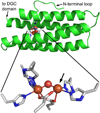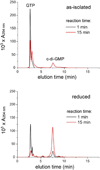A bacterial hemerythrin domain regulates the activity of a Vibrio cholerae diguanylate cyclase
- PMID: 23057727
- PMCID: PMC3549010
- DOI: 10.1021/bi3011797
A bacterial hemerythrin domain regulates the activity of a Vibrio cholerae diguanylate cyclase
Abstract
The first demonstrated example of a regulatory function for a bacterial hemerythrin (Bhr) domain is reported. Bhrs have a characteristic sequence motif providing ligand residues for a type of non-heme diiron site that is known to bind O(2) and undergo autoxidation. The amino acid sequence encoded by the VC1216 gene from Vibrio cholerae O1 biovar El Tor str. N16961 contains an N-terminal Bhr domain connected to a C-terminal domain characteristic of bacterial diguanylate cyclases (DGCs) that catalyze formation of cyclic di-(3',5')-guanosine monophosphate (c-di-GMP) from GTP. This protein, Vc Bhr-DGC, was found to contain two tightly bound non-heme iron atoms per protein monomer. The as-isolated protein showed the spectroscopic signatures of oxo/dicarboxylato-bridged non-heme diferric sites of previously characterized Bhr domains. The diiron site was capable of cycling between diferric and diferrous forms, the latter of which was stable only under anaerobic conditions, undergoing rapid autoxidation upon being exposed to air. Vc Bhr-DGC showed approximately 10 times higher DGC activity in the diferrous than in the diferric form. The level of intracellular c-di-GMP is known to regulate biofilm formation in V. cholerae. The higher DGC activity of the diferrous Vc Bhr-DGC is consistent with induction of biofilm formation in low-dioxygen environments. The non-heme diiron cofactor in the Bhr domain thus represents an alternative to heme or flavin for redox and/or diatomic gas sensing and regulation of DGC activity.
Figures









Similar articles
-
N-terminal truncation of VC0395_0300 protein from Vibrio cholerae does not lead to loss of diguanylate cyclase activity.Biophys Chem. 2021 Jan;268:106493. doi: 10.1016/j.bpc.2020.106493. Epub 2020 Oct 10. Biophys Chem. 2021. PMID: 33152620
-
Structure of the active GGEEF domain of a diguanylate cyclase from Vibrio cholerae.Biochem Biophys Res Commun. 2020 Mar 5;523(2):287-292. doi: 10.1016/j.bbrc.2019.11.179. Epub 2019 Dec 18. Biochem Biophys Res Commun. 2020. PMID: 31862141
-
The Vibrio cholerae diguanylate cyclase VCA0965 has an AGDEF active site and synthesizes cyclic di-GMP.BMC Microbiol. 2014 Feb 4;14:22. doi: 10.1186/1471-2180-14-22. BMC Microbiol. 2014. PMID: 24490592 Free PMC article.
-
Diguanylate Cyclases in Vibrio cholerae: Essential Regulators of Lifestyle Switching.Front Cell Infect Microbiol. 2020 Oct 22;10:582947. doi: 10.3389/fcimb.2020.582947. eCollection 2020. Front Cell Infect Microbiol. 2020. PMID: 33194821 Free PMC article. Review.
-
Bacterial diguanylate cyclases: structure, function and mechanism in exopolysaccharide biofilm development.Biotechnol Adv. 2015 Jan-Feb;33(1):124-141. doi: 10.1016/j.biotechadv.2014.11.010. Epub 2014 Dec 10. Biotechnol Adv. 2015. PMID: 25499693 Review.
Cited by
-
Nitric oxide stimulates type IV MSHA pilus retraction in Vibrio cholerae via activation of the phosphodiesterase CdpA.Proc Natl Acad Sci U S A. 2022 Feb 15;119(7):e2108349119. doi: 10.1073/pnas.2108349119. Proc Natl Acad Sci U S A. 2022. PMID: 35135874 Free PMC article.
-
Members of the Genus Methylobacter Are Inferred To Account for the Majority of Aerobic Methane Oxidation in Oxic Soils from a Freshwater Wetland.mBio. 2018 Nov 6;9(6):e00815-18. doi: 10.1128/mBio.00815-18. mBio. 2018. PMID: 30401770 Free PMC article.
-
Gas and light: triggers of c-di-GMP-mediated regulation.FEMS Microbiol Rev. 2023 Jul 5;47(4):fuad034. doi: 10.1093/femsre/fuad034. FEMS Microbiol Rev. 2023. PMID: 37339911 Free PMC article. Review.
-
The Oxidative Stress-Induced Hypothetical Protein PG_0686 in Porphyromonas gingivalis W83 Is a Novel Diguanylate Cyclase.Microbiol Spectr. 2023 Jan 31;11(2):e0441122. doi: 10.1128/spectrum.04411-22. Online ahead of print. Microbiol Spectr. 2023. PMID: 36719196 Free PMC article.
-
Development of Ratiometric Bioluminescent Sensors for in Vivo Detection of Bacterial Signaling.ACS Chem Biol. 2020 Apr 17;15(4):904-914. doi: 10.1021/acschembio.9b00800. Epub 2020 Mar 25. ACS Chem Biol. 2020. PMID: 32186367 Free PMC article.
References
-
- Romling U, Gomelsky M, Galperin MY. C-di-GMP: the dawning of a novel bacterial signalling system. Mol. Microbiol. 2005;57:629–639. - PubMed
-
- Hengge R. Principles of c-di-GMP signalling in bacteria. Nature Rev. Microbiol. 2009;7:263–273. - PubMed
-
- Wolfe AJ, Visick KL, editors. The second messenger cyclic di-GMP. Washington, DC: ASM Press; 2010.
Publication types
MeSH terms
Substances
Grants and funding
LinkOut - more resources
Full Text Sources
Molecular Biology Databases

